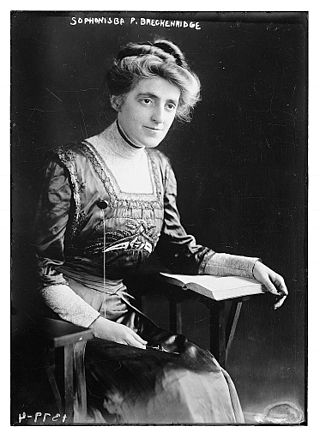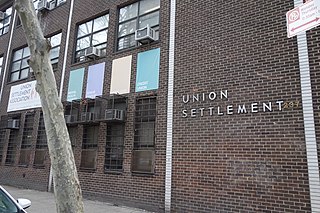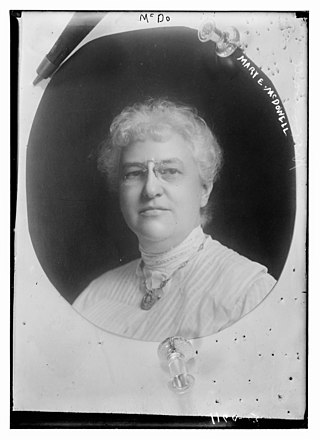
Laura Jane Addams was an American settlement activist, reformer, social worker, sociologist, public administrator, philosopher, and author. She was an important leader in the history of social work and women's suffrage in the United States. Addams co-founded Chicago's Hull House, one of America's most famous settlement houses, providing extensive social services to poor, largely immigrant families. In 1910, Addams was awarded an honorary master of arts degree from Yale University, becoming the first woman to receive an honorary degree from the school. In 1920, she was a co-founder of the American Civil Liberties Union (ACLU).

Hull House was a settlement house in Chicago, Illinois, that was co-founded in 1889 by Jane Addams and Ellen Gates Starr. Located on the Near West Side of Chicago, Hull House, named after the original house's first owner Charles Jerald Hull, opened to serve recently arrived European immigrants. By 1911, Hull House had expanded to 13 buildings. In 1912, the Hull House complex was completed with the addition of a summer camp, the Bowen Country Club. With its innovative social, educational, and artistic programs, Hull House became the standard bearer for the movement; by 1920, it grew to approximately 500 settlement houses nationally.

Julia Clifford Lathrop was an American social reformer in the area of education, social policy, and children's welfare. As director of the United States Children's Bureau from 1912 to 1922, she was the first woman ever to head a United States federal bureau.
The settlement movement was a reformist social movement that began in the 1880s and peaked around the 1920s in the United Kingdom and the United States. Its goal was to bring the rich and the poor of society together in both physical proximity and social interconnectedness. Its main object was the establishment of "settlement houses" in poor urban areas, in which volunteer middle-class "settlement workers" would live, hoping to share knowledge and culture with, and alleviate the poverty of, their low-income neighbors. The settlement houses provided services such as daycare, English classes, and healthcare to improve the lives of the poor in these areas. The settlement movement also spawned educational/reform movements. Both in the UK and the US settlement workers worked to develop a unique activist form of sociology known as Settlement Sociology. This science of social reform movement is neglected in the history of sociology in favor of a teaching, theory and research university-based model.

Sophonisba Preston Breckinridge was an American activist, Progressive Era social reformer, social scientist and innovator in higher education. She was the first woman to earn a Ph.D. in political science and economics then the J.D. at the University of Chicago, and she was the first woman to pass the Kentucky bar. In 1933, President Franklin D. Roosevelt sent her as a delegate to the 7th Pan-American Conference in Uruguay, making her the first woman to represent the U.S. government at an international conference. She led the process of creating the academic professional discipline and degree for social work. During her life she had relationships with Marion Talbot and Edith Abbott

Frances Alice Kellor was an American social reformer and investigator, who specialized in the study of immigrants to the United States and women.

Americanization is the process of an immigrant to the United States becoming a person who shares American culture, values, beliefs, and customs by assimilating into the American nation. This process typically involves learning the American English language and adjusting to American culture, values, and customs.

The University Settlement Society of New York is an American organization which provides educational and social services to immigrants and low-income families, located at 184 Eldridge Street on the Lower East Side of the Manhattan borough of New York City, New York. It provides numerous services for the mostly immigrant population of the neighborhood and has since 1886, when it was established as the first settlement house in the United States.

Union Settlement is one of the oldest settlement houses in New York City, providing community-based services and programs that support the immigrant and low-income residents of East Harlem since 1895. It is East Harlem’s largest social service agency and serves 10,000 people annually through programs including early childhood education, youth services, senior services, adult education, mental health, small business development and community outreach.
The Downtown Community House at 105-107 Washington Street is a six-story, five-bay red brick building that is among the last vestiges of the Lower West Side of Manhattan's former life as an ethnic neighborhood known as “Little Syria.” From the time of its establishment, the Bowling Green Neighborhood Association, housed in the Downtown Community House beginning in 1926, was a pioneering organization that served the local immigrant population as a settlement house and continued to provide services for the area well after the community house became defunct. Built in 1925 with philanthropic funds from William H. Childs, the founder of the Bon Ami household cleaner company, the Downtown Community House was designed by John F. Jackson, architect of over 70 Y.M.C.A. buildings and community centers, and through its Colonial Revival style speaks to an underlying desire for the neighborhood's immigrant population to become Americanized and associate themselves with the country's foundations. In recent years, a collection of historic preservationists and Arab-American activists have lobbied the Landmarks Preservation Commission and its chairman Robert Tierney to designate the building as a city landmark.

Chicago Commons, known since 1954 as the Chicago Commons Association, is a social service organization and former settlement house in Chicago, Illinois, in the United States. Originally located on the near Northwest Side and now headquartered in Chicago's Bronzeville neighborhood, it serves underresourced communities throughout the city.
Edith Bremer (1885–1964) was born in Hamilton N.Y. and graduated from the University of Chicago in 1907. She pioneered immigrant social service work and had a major influence on the institute movement. She founded and led the International Institute movement, which was focused on improving the lives of female immigrants. The International Institute was a movement for cultural pluralism with efforts towards protection of immigrant girls in 1910. She was a resident at the University Chicago settlement as well as a researcher for the Chicago Women's Trade Union League. She then became a special agent for the United States Immigration Commission and also worked as a field investigator for the Chicago Juvenile Court. These field works inspired her to focus on the problems of female immigrants. She believed that other immigrant social welfare agencies, both public and private, poorly served women.

Mary Eliza McDowell was an American social reformer and prominent figure in the Chicago Settlement movement.
The Houchen Settlement House was founded in 1912 in El Segundo Barrio in El Paso, Texas.

Socialhousekeeping, also known as municipal or civil housekeeping, was a socio-political movement that occurred primarily through the 1880s to the early 1900s in the Progressive Era around the United States.

The College Settlements Association (CSA) was an American organization founded during the settlement movement era which provided support and control of college settlements for women. Organized February 1890, it was incorporated on January 5, 1894. The settlement houses were established by college women, were controlled by college women, and had a majority of college women as residents. The CSA was devised to unite college women in the trend of a modern movement, to touch them with a common sympathy, and to inspire them with a common ideal. It was believed that young students should be quickened in their years of vague aspiration and purely speculative energy by possessing a share in this broad practical work.

Rivington Street Settlement was an American settlement house which provided educational and social services on the Lower East Side of the Manhattan borough of New York City, New York. Under the auspices of the College Settlements Association (CSA), it focused on the mostly immigrant population of the neighborhood. Originally located at 95 Rivington Street (1889-), other locations later included 96 Rivington Street (1892-1901), 188 Ludlow Street (1902–), 84-86 First Street (1907-), and Summer Home, Mount Ivy, New York (1900-). The Rivington Street Settlement was established by college women, was controlled by college women, and had a majority of college women as residents. The Rivington Street Settlement was a kind of graduate school in economics and sociology, with practical lessons in a tenement–house district - a kind of sociological laboratory.

Alice P. Gannett was an American settlement house worker and social reformer. The Goodrich-Gannett Neighborhood Center in Cleveland, Ohio, is named in her honor.
Neighborhood House is an American community center located in Louisville, Kentucky. Founded in 1896, as North Broadway Social Settlement it was renamed Neighborhood House in 1902, when it incorporated.



















